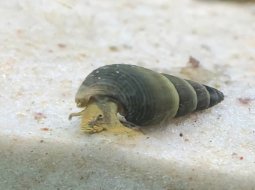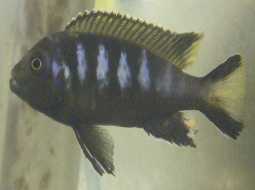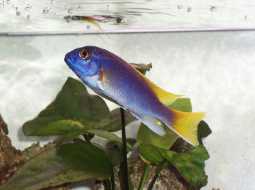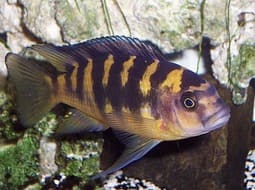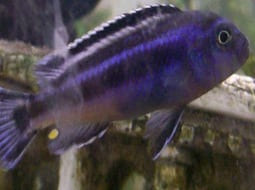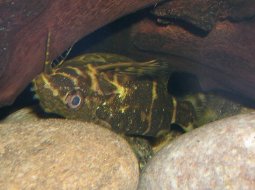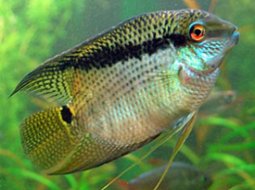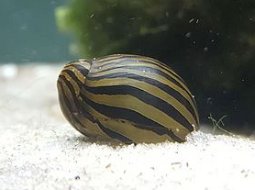
Loading Aqualapp ...
Care and Compatibility of Duboisi Cichlid - Tropheus duboisi
Introduction
The Duboisi Cichlid has a robust and laterally compressed body. Its characteristic coloration consists of a black background with white spots or dots all over the body, including the fins. Males typically have larger and more distinct spots than females. In addition to its color pattern, they can develop a prominent hump on the head as they grow.
Behavior
The Duboisi Cichlid, also known as Tropheus duboisi, is a fish native to Lake Tanganyika in Africa. It is known for its distinctive black and white coloration pattern and territorial behavior. Males are usually larger and have more intense coloration than females. They are active and energetic fish that can display aggressive behavior towards other fish of the same species.
Sexual Dimorphism
Sexual dimorphism in Tropheus duboisi is minimal and difficult to distinguish. Both males and females have a similar appearance, although males may be slightly larger and more colorful during breeding season.
Reproduction
Breeding Duboisi Cichlids can be challenging in captivity due to their territorial and aggressive behavior. To breed them, it is recommended to provide them with a large tank with rocks and caves to create separate territories. The female will lay her eggs on a flat surface, and the male will fertilize them. The parents should be separated after breeding to prevent them from consuming the eggs or fry.
Aquarium Conditions
Tropheus duboisi, commonly known as the Duboisi cichlid, requires a large, well-decorated aquarium with plenty of rocks to form structures and hiding spots. It prefers alkaline water and a warm temperature. Aquarium décor should include stacked rocks and minimal vegetation. Maintaining water quality is crucial and providing a balanced diet.
Feeding
When it comes to feeding, the Duboisi Cichlid is primarily herbivorous. In the wild, it feeds on algae and other plant material found in its habitat. In the aquarium, a varied diet can be provided, including plant-based foods such as flake or pellet food with spirulina, as well as suitable frozen or live foods for herbivorous fish.
Complexity
Caring for Tropheus duboisi can be challenging. They are territorial and aggressive fish, especially during breeding season. It's recommended to keep them in large groups and in a spacious tank to distribute aggression. They are herbivores and their diet should consist mainly of vegetable-based foods.
In case you need more help, or if you want to know into any topic related to the Tropheus duboisi (Duboisi Cichlid) and even any other species you can use the forums to ask what you need.
To do an analysis more detailed about coexistence and behavior of Tropheus duboisi (Duboisi Cichlid) use the Aquarium simulation tool, if you do this you can test different ways to combine the Duboisi Cichlid with other fishes giving the dimensions and space on you aquarium, on this way you can known the optimal configuration for keep the fishes that you want.
You can also find out the 14 species compatible with the Tropheus duboisi (Duboisi Cichlid) can live together.
Note: The parameters of the water such as PH and temperature are also used to calculate the compatibility of the species.
Compatible species (14)
Compatible (1 Species)
With Reservation (11 Species)
Estos peces son ciclidos africanos del lago Malawi agresivos, por lo general pueden convivir con otros Mbunas agresivos si cuentan con espacio suficiente en el acuario, rocas y escondites donde puedan refugiarse de ser necesario.
Compatible in some cases, it depends on the nature and personality of the fish.
Las especies territoriales por lo general pueden convivir con especies protegidas con coraza, ya que no pueden hacerles daño por su dura piel, lo que si hay que tener en cuenta es tener un acuario con dimensiones favorables para que cada pez pueda delimitar un territorio, ya que la mayoría de peces acorazados son también peces de fondo y les gusta estar buscando lugares donde ocultarse.
Showdown over territory (1 Species)
Fish can live together as long as the space is spacious enough to delimit a territory, otherwise there may be aggressions for competing for the territory.
Considerable size difference (1 Species)
They can coexist while they are similar in size or the size difference is not very abysmal, since as the fish grows it increases the chances of eating its partner that did not grow much.
Duboisi Cichlid
Tropheus duboisi

- Ph: 8 - 9.5
- Temperature (c°): 23 - 28
- Measures: 10 cm - 12cm
- Aquarium Capacity:
18 Liters - 5 Gallons - Alimentación: Herbivores
- Colores: Black, Blue, White
- Comportamiento: Territorial
- Habitad: African
- Preferencias del Acuario: Rocks
- Tamaño: Medium
- Taxonomía: Cichlids, Fish, Mbunas
- Tipo de Agua: Sweet water, Tropical waters
- Velocidad de nado o movimiento: Normal
- Zona de Nado: Swim in the middle of the aquarium


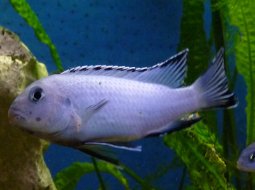
.jpg)
